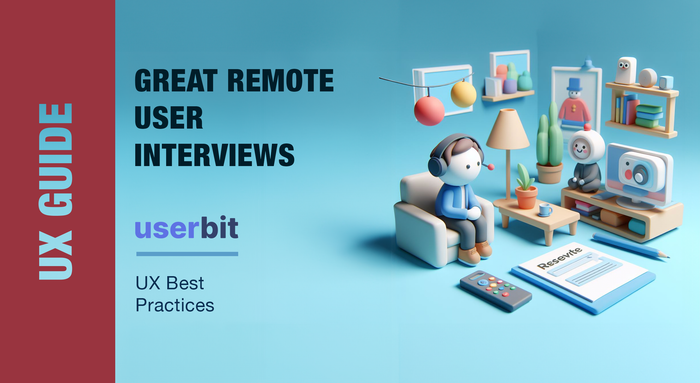
How to Conduct a Great Remote User Interview
In-person interviews used to be the go-to for user research due to the natural ease of face-to-face communication. But lately, remote user research is picking up steam.
It's pretty handy, actually — you get a bigger mix of people to chat with, cut down on travel time and expenses, and it's easier for folks to join in from wherever they are.
Our guide today has a bunch of tips that work for both in-person and remote chats, but we're really zeroing in on making your remote user research sessions as smooth as possible.
1. Select the right participants for your remote research
Remote interviews often lead to higher participation rates and more candid responses due to their convenience.
Why? Participants can join from the comfort of their homes or workplaces, making it easier for them to engage in the research process. This increased flexibility can get you more authentic perspectives as participants don’t need to be in an unfamiliar environment for the session!
Remote interviews also offer a global reach that can help you access a broader and more varied audience. This allows you to enrich your research with more diverse viewpoints than what in-person interviews can afford.
Diverse backgrounds, professions, or geographic regions can all contribute positively to your research.
Example: Suppose you're developing a food tracking app designed to help users maintain a healthy diet and lifestyle. Instead of exclusively targeting local fitness enthusiasts, remote interviews expand your research’s reach allowing you to include participants who represent different user segments:
Alex: A university student just beginning their fitness journey.
Pat: An individual who prefers manual, non-digital methods for tracking their diet.
Emma: A busy working professional seeking convenience in managing her nutrition.
By lumping in this diverse group, you can get more information into how different users (with varying levels of familiarity and preferences) interact with your app remotely. This approach allows you to assess the app's usability, appeal, and effectiveness across a broader user spectrum.
Tip: If your app or product (in this case, a food tracking app) is intended for a global audience, leverage remote interviews to include participants from different regions and cultural backgrounds. Their input can highlight region-specific dietary preferences and nutritional needs, ensuring that your app caters to a wide user base.However, keep in mind that not every individual will be equally valuable for remote user research.
Participants who have no interest in health and fitness or those who don't use apps may not align with your research goals. That’s why making sure each participant can contribute meaningfully is important!
2. Develop excellent interview questions
Asking good interview questions is vital to encourage detailed and narrative responses from your participants. You want to get them comfortable enough to tell you their life story!
How do you do that? Focus on open-ended questions that delve into their behaviors, motivations, and needs, steering clear of simple yes/no formats.
Example: When conducting interviews for your food tracking app, avoid questions like "Do you find our app easy to use?"
Instead, ask open-ended questions such as "Can you describe your experience using our app to track your meals and workouts?” and “What challenges have you encountered, if any?"
3. Choose the right tools
Selecting the right tools for your remote research and analysis can make a world of difference. Here's what you need to keep in mind:
Tools for conducting remote Interviews
- Go for user-friendly platforms. Interview platforms that are user-friendly and easy to navigate are ideal, especially if you’re in a rush to get your research going.
- Reliability matters. You want a platform that offers stable video and audio connections (ugh, imagine the frustration if your interview gets interrupted due to technical glitches!). So choose a platform that you can count on.
- Recording is a must. Having a platform that allows you to record your remote interviews lets you revisit the sessions later for a deeper dive into the insights. Plus, you can transcribe and share the recordings with team members who couldn't make it to the interview.
- Screen sharing for clarity. Consider a tool that allows screen sharing like Google Meets or Zoom. It's a handy feature that lets you show participants product features, user interfaces, or prototypes in real time. It adds a visual element to your discussions.
- Consider a chat for interaction feature. Having a chat function can be very useful since it allows participants to ask questions or share thoughts without interrupting the conversation. It's like a virtual sticky note for instant feedback!
Tools for analyzing interviews
So you’ve now conducted your interviews and have a bunch of recordings. What’s next? This is when you can really benefit from having a centralized repository where you can organize and analyze these interviews. The Following are the must have features for your research repository tools:
-
Participant management
Being organized with the qualitative data collected during remote interviews is one of the prerequisites for efficient analysis. Participant management allows you to consolidate all your participant information, interviews, notes, and files into one organized system, making it easy for you to navigate through the relevant data. UserBit's participant management tool for example, lets you add attributes to participant profiles (like their headshot, phone number, etc.) and gives you the ability to share participant and stakeholder information across various projects within your workspace. Yay for flexibility!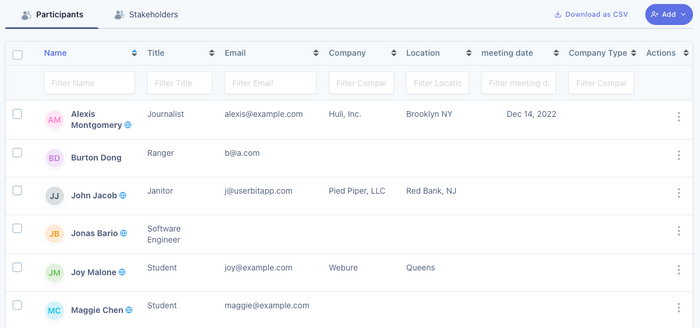 Participant management on UserBit
Participant management on UserBit -
Accurate transcription recordings
If you are conducting remote interviews, chances are that you end up with a ton of video or audio recording of your sessions. It goes without saying that automatic transcriptions of these recordings can save you a ton of time when it comes to analysis. Before picking a tool for transcribing though, you need to ensure that the accuracy and quality of the transcriptions are up to your standards. Otherwise you would end up spending more time correcting the transcripts than actually analyzing them. It should come as no surprise then, that we provide a lot of TLC to our transcription feature. Not only does UserBit AI produce highly accurate transcriptions in multiple languages, it also automatically identifies and categorizes speech by each speaker, making analyzing your interviews a breeze.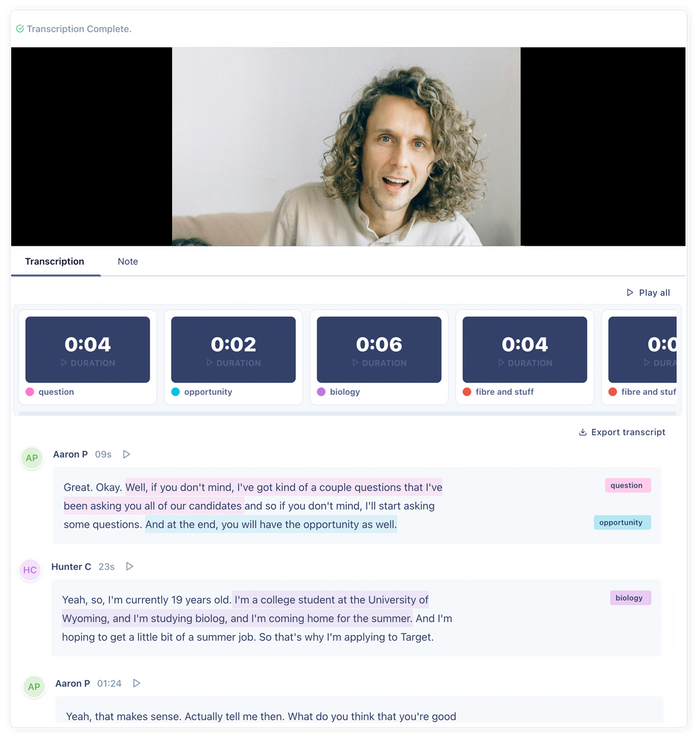 Transcribe and analyze user and stakeholder interviews
Transcribe and analyze user and stakeholder interviews -
Qualitative data analysis
Qualitative analysis tools help you grasp the subtle details in your research by finding hidden patterns, themes, and insights at scale . For example, methods like tagging, word clouds, and affinity diagrams are excellent for providing detailed and nuanced examination of textual data, interviews, and responses from surveys.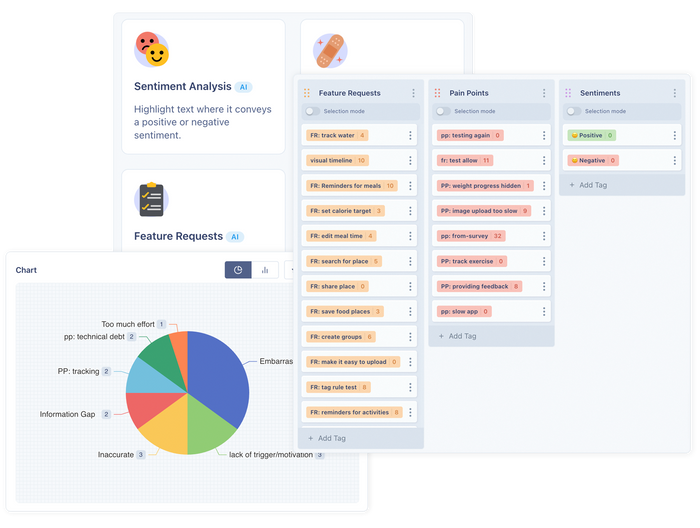 Analyze your data in minutes
Analyze your data in minutes -
Insight management
You’ve done your analysis and have some pretty juicy insights. But how do you convince your stakeholders that your insights are backed up by real data? The insights on UserBit allow you to attach data from your research like charts, customer quotes, and tags, images, and video clips directly to your findings so your stakeholders never have to guess or wonder about your conclusions.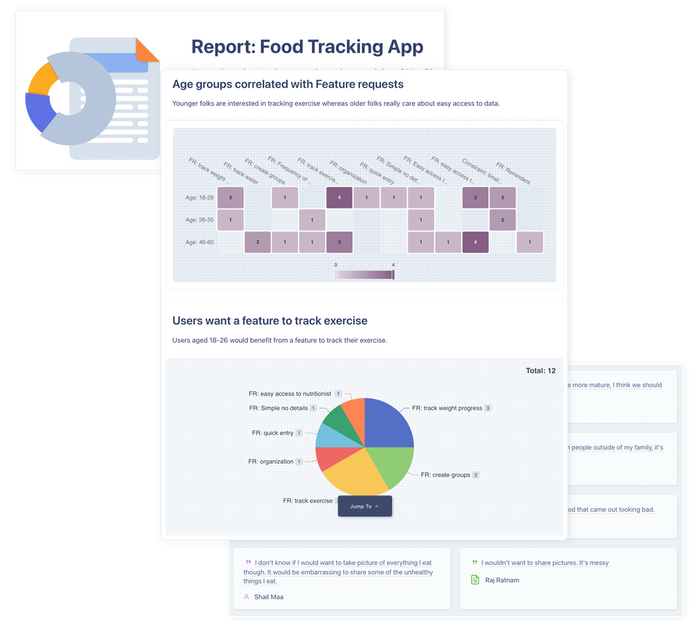 Capture hidden patterns in your data using insights
Capture hidden patterns in your data using insights -
Sharing with stakeholders
Because sharing your work is just as important as actually doing it, you need to pick an analysis tool that makes sharing a core offering of the product. Specifically, the tool you pick should allow: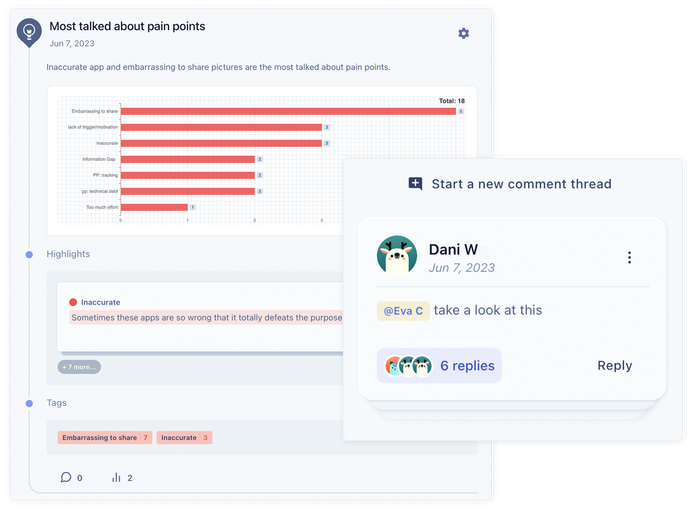 Share your findings with anyone you want without having them learn a new platform
Share your findings with anyone you want without having them learn a new platform- You to share different parts of your research individually or as a report - recordings, interviews, insights, etc.
- You to share your work continuously so the stakeholders are always in the loop.
- Stakeholders to review your findings in a format that doesn't require them to learn a new platform.
- Stakeholders to communicate via the tool in context of your findings (example - real-time comments).
So how do we solve this at UserBit? UserBit allows you to share individual assets (like notes, interviews, insights, etc) directly from your research via secure links.
You can also share customized case study reports with your stakeholders to give them a complete picture of your findings.
For those who are interested in continuous research and delivery, UserBit also has a Client Portal. You can choose what insights to share, which means you’ll have an easily accessible, organized platform that's separate from your workspace, so an unlimited number of teammates or stakeholders can clearly see your most relevant findings and data without a hitch.
Test everything
Before the actual interviews, make sure to test the chosen tools that the video and audio quality, screen sharing, and chat features are all good to go!
Before you do any real interviews, do some trial runs with colleagues or friends to iron out any wrinkles.
By going for user-friendly and reliable platforms, recording your interviews, considering screen sharing and chat functions, and doing some pre-interview testing, you'll have everything set up for a chill and trouble-free remote interview session.
The focus should always be on gathering those valuable insights without any tech-related hiccups.
4. Conduct the remote interview thoughtfully
Here are a tips we recommend always doing when holding remote user interviews:
Emphasize listening
In remote user interviews, effective listening takes center stage, so prioritize listening over speaking, paying close attention to nuances in participants' responses, and encouraging them to expand on their answers.
Leave your own assumptions behind
Before jumping straight into specific product details, challenge and validate your assumptions about user needs. This approach ensures that your research aligns accurately with real user requirements.
Example: Perhaps your assumption is that users of your food tracking app prioritize calorie counting above all else. During the interview, ask participants about their primary goals and motivations when tracking their food intake. If you discover that many users are more concerned about ingredient quality or allergen information, this insight could reshape your product priorities.
Implement the four-step questioning method
A structured questioning approach can provide clarity and consistency to your interviews.
Consider the following four steps:
Initial thoughts: Capture participants' initial reactions to understand their immediate perceptions.
Reasoning: Go deeper by probing into the reasons behind these initial thoughts.
Value assessment: Determine the perceived usefulness or relevance of specific app features.
Understanding value: Gain insight into the significance of these features from the user's perspective.
5. Review and reflect post-interview
After each remote user interview, take a moment to review and reflect on the conversation. The idea here is that with a little time and perspective, you can capture fresh insights that may have emerged during the discussion.
Collaboration is key in UX research, so share your interview findings with your team. Your colleagues or team members may have valuable suggestions to refine your interview approach. They can provide tips on improving your questions, listening skills, or overall interview technique.
With them, you can discuss what you learned, any surprises, or patterns you noticed, and you’ll be able to refine your interview approach over time.
To wrap up
In conclusion, remote user interviews are a hugely powerful tool in UX research when conducted with careful planning and strategy.
By focusing on effective preparation, precise questioning, active listening, and detailed analysis, you can get excellent information that’s crucial for user-centered design and product success.
Whether you're developing a food tracking app, a fitness platform, or any digital product, these principles can help you master any type of remote user research.

